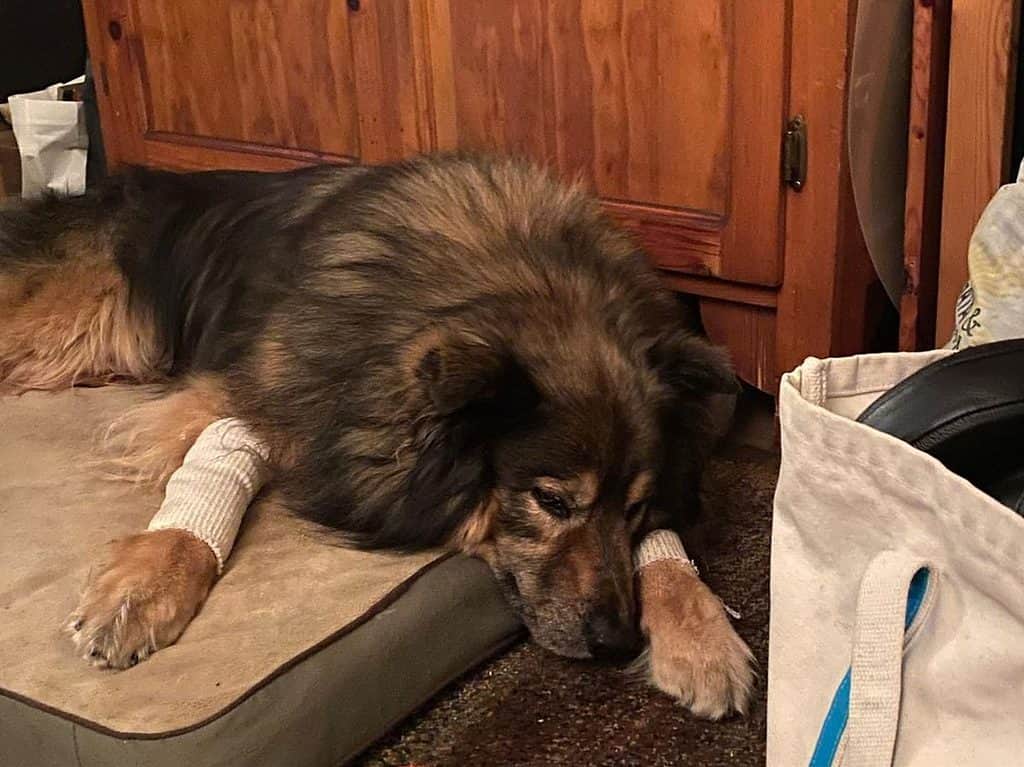It’s the last thing you want — ending your furry friend’s life.
But when your dog has lymphoma, this is sometimes necessary so that your dog does not suffer needlessly.
With this in mind, knowing when to put a dog down with lymphoma is essential. This guide discusses the signs that indicate it’s time to make that hard call and offers helpful tips for grieving owners.

What Is Lymphoma In Dogs
Lymphoma is caused by the uncontrolled growth of white blood cells in a dog’s lymphatic system, the body’s primary defense against infection.
Research says that there are over 30 different types of canine lymphoma
Lymphoma is one of the most serious types of cancer in dogs, and understanding the different types can help you recognize the signs of this condition early on. Here’s a look at some common forms of lymphoma in dogs.
By far, the most prevalent type of canine lymphoma is multicentric (systemic) lymphoma. Multicentric lymphoma occurs in 80-85 percent of canine lymphoma cases and causes the swelling or enlargement of multiple lymph nodes throughout the body.
There’s also alimentary lymphoma which affects the gastrointestinal fact and causes weight loss, diarrhea, and vomiting in dogs.
The third type of canine lymphoma, mediastinal, targets the chest’s lymphoid organs, causing breathing difficulty, increased thirst, increased urination, and swelling of the face and front legs.
The rarest among canine lymphomas, extranodal, grows outside of the lymph nodes, usually affecting areas like the mouth, bones, eyes, liver, skin, breast, lungs, and kidneys.
How Is Lymphoma Diagnosed
The first step in diagnosing canine lymphoma is taking a complete physical exam of your pet. Your veterinarian will look for enlarged lymph nodes or other lumps around the body, changes in the coat or skin texture, and any other abnormalities throughout the body.
They might also take a sample of your dog’s tissue to test for cancer cells or take an x-ray if they suspect tumors are present.
Blood tests can also help with diagnosis by revealing high levels of white blood cells typically seen in canine lymphoma cases.
What Are The Treatments For Canine Lymphoma
The answer depends on how advanced your dog’s lymphoma is and what type of lymphoma they’re diagnosed with.
In general, treatments usually involve chemotherapy. This process uses chemotherapy drugs to target and destroy cancer cells while minimizing damage to healthy tissue. Common side effects include decreased appetite, diarrhea, fatigue, and vomiting. While these symptoms typically subside after the treatment has been completed, some long-term problems, such as anemia or organ damage, may arise due to the toxicity of the drugs used during chemo.
But the cool thing is that dogs rarely suffer hair loss or shedding after chemotherapy compared to humans.
When lymphoma does not respond to chemotherapy, it may be necessary to remove the spleen surgically. This procedure is known as splenectomy.
Lymphoma can also be removed if caught early enough, so it’s always best to start the fight against this disease with surgery as soon as possible. The earlier treatment begins, the more effective the results and chances of beating it.
Putting A Dog Down: What We Know About Euthanasia
Euthanasia in dogs is a difficult decision that pet owners must face when their beloved companion’s health fails. From terminal illnesses to extreme anxiety, the decision to euthanize a pet can be emotionally overwhelming for all involved.
When faced with this devastating situation, pet parents often want to ensure they make the best choice for their dog and family. Understanding what euthanasia entails and how it works can help alleviate some of the stress associated with such a heavy decision.
Euthanasia in dogs begins with a tranquillizer, which relaxes your pup, so they don’t feel any pain or distress during the process. Afterwards, a lethal injection of the euthanasia drug is administered by experienced veterinarians who understand that everyone involved needs special care at this difficult time.
Putting a dog down may be heartbreaking, but the silver lining is that this is a painless process. It also provides closure, knowing that your dog was given peace from suffering.
Now that you know what lymphoma and euthanasia are, let’s find out when you should decide it’s time.
What’s The Verdict? When To Put A Dog Down With Lymphoma?

The answer will vary depending on the individual case. Still, if your pup’s quality of life has become too compromised due to lymphoma or treatments no longer seem viable, euthanasia might be the most compassionate choice.
If they can no longer participate in activities that once brought them joy, such as playing or even standing, or if their pain caused by cancer has become unmanageable, it could be time to consider putting them down.
Once the difficult decision to put a beloved dog down with lymphoma has been made, it can be heartbreaking for all family members involved. Saying goodbye to a cherished pet is never easy; however, there are some things one can do to make the experience more bearable.
First of all, ensure everyone in the family has an opportunity to say their goodbyes before the euthanasia process begins. This may mean taking turns having private moments with your pet or even taking photos together to cherish those last memories.
It can also be beneficial for family members to talk about positive memories and experiences shared with their furry friend. You will ultimately find closure in this painful process by sharing stories of joyous moments and celebrating your pet’s life.
Post-Euthanasia: How To Cope Up With The Loss Of Your Dog
The first thing to do is give yourself time and space to mourn your pet’s passing. Don’t rush or force yourself into feeling better; it takes time for healing to occur.
Surround yourself with supportive people who also understand what it’s like to lose a furry companion, and allow yourself time each day to reflect on the happy memories shared with your pup.
But if you are finding it difficult to cope with the loss of a beloved animal companion, channel all your longing into another dog. It can seem overwhelming at first to think about introducing another dog into your life after saying goodbye to one that was so special but consider taking this as an opportunity for growth and healing. You will soon find comfort in connecting with a new pup.
This doesn’t mean replacing what you had before but opening yourself up to giving love and receiving it again from a furry friend who needs it just as much as you do. Believe us; this will speed up your healing process!
FAQS
What are the symptoms of canine lymphoma in the final stage?
Your dog will suffer the most in the final stage of canine lymphoma. You may notice that your dog is disoriented, restless, unable to move or stand, unwilling to eat and panting excessively.
How fast does lymphoma in dogs progress?
The answer depends on the individual dog, but studies suggest that it’s incredibly rapid. Untreated dogs have an average lifespan of four to five weeks after diagnosis.
References
Zandvliet, M. (2016). Canine lymphoma: a review. Veterinary Quarterly, 36(2), 76-104.
McMullen, S. L., Clark, W. T., & Robertson, I. D. (2001). Reasons for the euthanasia of dogs and cats in veterinary practices. Australian Veterinary Practitioner, 31(2), 80-84.




